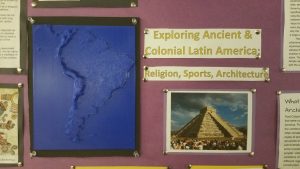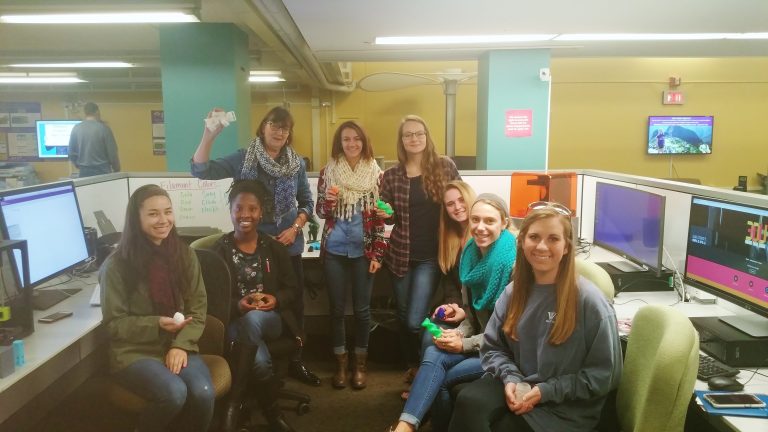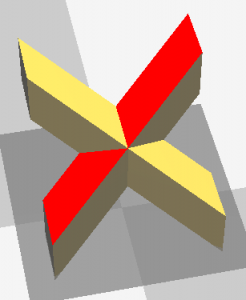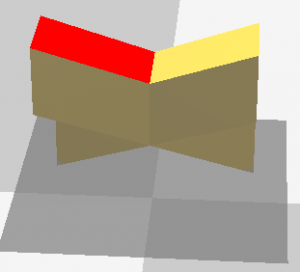Ashley Hyatt Vestibular Models
For Ashley Hyatt’s physical therapy class, the 3DU were able to assist by providing 3D printed models of the Cochlea, which is a small portion of the inner ear. Students were able to take the 3D printed models and color them, labeling each part of the inner ear workings. This allowed them to use the models for presentations and provided a visual representation of their work. Take a look at the video below to see how this was done.
Biology 493 (Professor Amanda Storm)
This fall, the students of Amanda Storm’s Biology 493 class got a firsthand look at some unique molecules with the help of 3D Printing. For a class project students had the opportunity to learn about protein structures by manipulating 3D models of the proteins. Using specialized software, students created and submitted a 3D model of the protein to the 3DU, where the technicians printed their models using plastic 3D Printers. The end result was a physical model of their protein that they got to submit with their class project. The current designs can be seen on display in the Natural Science building. For information on how your class can use 3D printing, or if you would like to print a Protein structure, email us at 3du.wcu.edu.
Latin American Studies (Professor Lily Balloffet)
 One of Western Carolina University’s newest History professors is allowing her students to experience the ruins of Machu Pichu without even leaving the classroom. Dr. Lily Balloffet, assistant professor in the department of History, has partnered with the Coulter Faculty Commons and the 3DU to create unique 3D Models for her classroom. Students in Dr. Balloffet’s Ancient and Colonial Latin America History Class have been able to experience hands on the ruins of Macchu, the topography of South America, and even a Mayan Calendar, among others, through the help of 3D models. Ballofet partnered with the 3DU to print a variety of models that she has used in her class to enhance instruction.
One of Western Carolina University’s newest History professors is allowing her students to experience the ruins of Machu Pichu without even leaving the classroom. Dr. Lily Balloffet, assistant professor in the department of History, has partnered with the Coulter Faculty Commons and the 3DU to create unique 3D Models for her classroom. Students in Dr. Balloffet’s Ancient and Colonial Latin America History Class have been able to experience hands on the ruins of Macchu, the topography of South America, and even a Mayan Calendar, among others, through the help of 3D models. Ballofet partnered with the 3DU to print a variety of models that she has used in her class to enhance instruction.
 As a special honors contract for her students, Ballofet partnered with Jonathan Wade from the Coulter Faculty Commons (CFC) to create a unique Latin American Cultural Exhibit. The CFC helped Dr. Ballofet obtain a grant to allow her honors students to create an interactive 3D Exhibit in the hall of McKee. Elizabeth Ianuzzi, Brookly Parham, and Greyson Rowlands selected open source models 3D Models of famous Latin American artifacts and created a 3D Billboard detailing the history and cultural significance of these objects.
As a special honors contract for her students, Ballofet partnered with Jonathan Wade from the Coulter Faculty Commons (CFC) to create a unique Latin American Cultural Exhibit. The CFC helped Dr. Ballofet obtain a grant to allow her honors students to create an interactive 3D Exhibit in the hall of McKee. Elizabeth Ianuzzi, Brookly Parham, and Greyson Rowlands selected open source models 3D Models of famous Latin American artifacts and created a 3D Billboard detailing the history and cultural significance of these objects.
The senior-level students in the Interior Design program printed the designs of their custom furniture class assignment on the 3D printer in the 3DU. The students’ assignment was to create a piece of custom designed furniture for their class studio project, which was a residential remodel of a historic house in Sylva.
Designing new furniture for the remodel of a historic residence

The senior-level students in the Interior Design program printed the designs of their custom furniture class assignment on the 3D printer in the 3DU. The students’ assignment was to create a piece of custom designed furniture for their class studio project, which was a residential remodel of a historic house in Sylva.
The students used the 3D printing process as a tool to develop their furniture designs. The 3D printing of their designs allowed the students to evaluate their design in three dimensionally. The students are currently incorporating these refinements into their designs, which they will be submitting to the Educational Foundation of the IFDA (International Furnishings and Design Association) Cliff Young LTD 2017 Contemporary-Modern Furniture Student Design Competition.
Jon Jincha Typography Alphabet Project
As part of Jon Jincha’s Typography class project, students were encouraged to put their own spin on the alphabet we know today. This project challenged students to alter the letters of the alphabet in a way that when they were seen, depending on the angle that they were viewed at, they could show a different view of what you would expect to see in regards to the alphabet we know today.
Once students had created their own version of the letters of the alphabet, the 3DU assisted with printing these creations so the students could have a phyiscal form of their creations to showcase and use during presentations.





